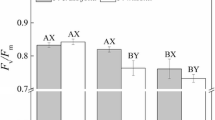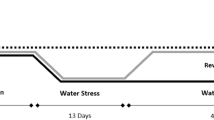Abstract
Significant expansion in the area of eucalypt plantations in Tasmania has led to their establishment at altitudes that are close to the upper limits of the planting distributions of Eucalyptus nitens and E. globulus, the main species planted. This has implications for plantation productivity. We investigated the processes that limit productivity in these environments through a study of freezing-induced depression of photosynthesis of E. nitens saplings in the field and plantlets of E. nitens and E. globulus clones in a controlled environment cabinet. In the field consecutive frosts of around –4.6°C had a cumulative effect, reducing maximum net photosynthesis ( A max) by 17%, and then a further 9%, respectively, compared with saplings insulated from the frosts. Shading saplings pre-dawn had no effect on A max measured after 1030 hours indicating that the reduction in A max at this time was independent of photoinhibition. Recovery of A max to pre-frost levels required at least two consecutive frost-free nights and was dependent on the severity of frost. Photosynthetic light response curves indicated that reduced A max was associated also with decreased quantum yield and stomatal conductance. Similar intracellular carbon dioxide concentration between exposed and insulated saplings indicated that low stomatal conductance did not limit photosynthesis through carbon dioxide limitation. The timing of frost events was critical: E. nitens saplings took less time to recover from reduced A max in the field when they were hardened. Unhardened plantlets of E. nitens and E. globulus clones had greater reduction of A max and took longer to recover from frost events than hardened plantlets. E. globulus was more susceptible to frost-induced reduction of A max than E. nitens. This is consistent with its planting range which is restricted to mild sites compared with that of E. nitens.





Similar content being viewed by others
References
Adams WW III, Demmig-Adams B (1992) Operation of the xanthophyll cycle in higher plants in response to diurnal changes in incident sunlight. Planta 186:390–98
Adams WW III, Demmig-Adams B, Verhoeven AS, Barker DH (1994) ‘Photoinhibition’ during winter stress: involvement of sustained xanthophyll cycle dependent energy dissipation. Aust J Plant Physiol 22:261–76
Ball MC (1994) The role of photoinhibition during tree seedling establishment at low temperatures. In: Baker NR, Bowyer JR (eds) Photoinhibition of photosynthesis: from molecular mechanisms to the field. Bios Scientific, London, pp 367 – 378
Ball MC, Hodges VS, Laughlin GP (1991) Cold induced photoinhibition limits regeneration of snow gum at treeline. Funct Ecol 5:663–68
Ball MC, Egerton JJG, Leuning R, Cunningham RB, Dunne P (1997) Microclimate above grass adversely affects spring growth of seedling snow gum ( Eucalyptus pauciflora). Plant Cell Environ 20:155–166
Battaglia M (2001) Mortality and stage age effects on productivity. In: Kirschbaum MUF, Mueller R (eds) Net ecosystem exchange. Cooperative Research Centre for Greenhouse Accounting, Canberra, Australia, pp 50–57
Berry J, Björkman O (1980) Photosynthetic response and adaptation to temperature in higher plants. Annu Rev Plant Physiol 31:491–543
Binkley D, Ryan MG, Stape JL, Barnard H (2002) Age-related decline in forest ecosystem growth: an individual-tree, stand-structure hypothesis. Ecosystems 5:58–67
Boland DJ, Brooker MI, Turnbull JW (1980) Eucalyptus seed. CSIRO, Canberra, pp 23–86, 119–130, 140–141
Chesterfield EA, McCormick MJ, Hepworth G (1991) The effect of low root temperature on the growth of mountain forest eucalypts in relation to the ecology of Eucalyptus nitens. Proc R Soc Victoria 103:67–76
Clements MM, Ludlow RJ (1977) Frost avoidance and frost resistance in Centrosema virginianum. J Appl Ecol 14:551–566
Close DC, Beadle CL, Brown PH, Holz GK (2000) Cold-induced photoinhibition affects establishment of Eucalyptus nitens (Deane and Maiden) Maiden and E. globulus Labill. Trees 15:32–41
Close DC, Davies NW, Beadle CL (2001a) Temporal variation of tannins (galloylglucoses), flavonols and anthocyanins in leaves of Eucalyptus nitens seedlings: implications for light attenuation and antioxidant activities. Aust J Plant Physiol 28:269–278
Close DC, Beadle CL, Hovenden MJ (2001b) Cold-induced photoinhibition and foliar pigment dynamics of Eucalyptus nitens seedlings during establishment. Aust J Plant Physiol 28:1133–1141
Cowan IR, Farquhar GD (1977) Stomatal function in relation to leaf metabolism and environment. In: Jennings DH (ed) Integration of activity in the higher plant. Cambridge University Press, Cambridge, pp. 471–505
Davidson NJ, Reid JB (1985) Frost as a factor influencing the growth and distribution of subalpine eucalypts. Aust J Bot 33:657–67
Dickinson KJM, Kirkpatrick JB (1986) The impact of grazing pressure on clearfelled, burned and undisturbed eucalypt forest. Vegetatio 66:133–136
Egerton JJG, Banks JCG, Gibson A, Cunningham RB, Ball MC (2000) Facilitation of seedling establishment: reducing light enhances winter growth of Eucalyptus pauciflora. Ecology 81:1437–1449
Epron D, Dreyer E, Breda N (1992) Photosynthesis of oak trees ( Quercus petraea (Matt.) Liebl.) during drought under field conditions: diurnal course of net CO2 assimilation and photochemical efficiency of Photosystem II. Plant Cell Environ 15:809–820
Greer DH, Robinson LA, Hall AJ, Klages K, Donnison H (2000) Frost hardening of Pinus radiata seedlings: effects of temperature on relative growth rate, carbon balance and carbohydrate concentration. Tree Physiol 20:107–114
Groot A, Carlson DW (1996) Influence of shelter on night temperatures, frost damage and bud break of white spruce seedlings. Can J For Res 26:1531–1538
Hallam PM, Tibbits WN (1988) Determination of frost hardiness of Eucalyptus using the electrical conductivity of diffusate in conjunction with a freezing chamber. Can J For Res 18, 595–600
Havaux M (1995) Temperature sensitivity of the photochemical function of photosynthesis in potato ( Solanum tuberosum) and a cultivated Andean hybrid ( Solanum × juzepczukii). J Plant Physiol 146:47–53
Holly C, Laughlin GP, Ball MC (1994) Cold-induced photoinhibition and design of shelters for establishment of eucalypts in pasture. Aust J Bot 42:139–147
Jarvis PG (1976) The interpretations of variations in leaf water potential and stomatal conductance found in canopies in the field. Phil Trans R Soc London Ser B 273:593–610
King DA, Ball MC (1998) A model of frost impacts on seasonal photosynthesis of Eucalyptus pauciflora. Aust J Plant Physiol 25:27–37.
Langvall O, Orlander G (2001) Effects of pine shelterwoods on microclimate and frost damage to Norway spruce seedlings. Can J For Res 31:155–164
Long SP, Hällgren J (1993) Measurement of CO2 assimilation by plants in the field and laboratory. In: Hall DO, Scurlock JMO, Bolhàr-Nordenkampf HR, Leegood RC, Long SP (eds) Photosynthesis and production in a changing environment. A field and laboratory manual. Chapman and Hall, London, pp 129–165
Long SP, Humphries S (1994) Photoinhibition of photosynthesis in nature. Annu Rev Plant Physiol Plant Mol Biol 45:633–662
Long SP, East TM, Baker NR (1983) Chilling damage to photosynthesis in young Zea mays. J Exp Bot 34:177–88
Moore RM, Williams JD (1976) A study of a subalpine woodland-grassland boundary. Aust J Ecol 1:145–53
Neilson RE, Ludlow MM, Jarvis PJ (1972) Photosynthesis in Sitka Spruce ( Picea sitchensis (Bong.) Carr.). II. Response to temperature. J Appl Ecol 9:721–45
Niyogi KK (1999) Photoprotection revisited: genetic and molecular approaches. Annu Rev Plant Physiol Plant Mol Biol 50:333–359
Nunez M, Bowman DMJS (1986) Nocturnal cooling in a high altitude stand of Eucalyptus delegatensis as related to stand density. Aust For Res 16:185–97
Orlander G (1993) Shading reduces both visible and invisible frost damage to Norway spruce seedlings in the field. Forestry 66:27–36
Örlander G, Langvall O (1993) The Asa Shuttle—a method for mobile sampling of air temperature and radiation. Scand J For Res 3:359–372
Ottander C, Campbell D, Öquist G (1995) Seasonal changes in photosystem II organisation and pigment composition in Pinus sylvestris. Planta 197:176–183
Raymond CA, Harwood CE, Owen JV (1986) A conductivity method for screening populations of eucalypts for frost damage and frost tolerance. Aust J Bot 34:377–393
SAS (1989) ‘SAS/STAT User’s Guide, Version 6’, vols 1 and 2. SAS Institute, Cary, N.C.
Slatyer RO, Ferrar PJ (1977a) Altitudinal variation in the photosynthetic characteristics of Snow Gum, Eucalyptus pauciflora Sieb. ex Spreng. II. Effects of growth temperature under controlled conditions. Aust J Plant Physiol 4:595–609
Slatyer RO, Ferrar PJ (1977b) Altitudinal variation in the photosynthetic characteristics of Snow Gum, Eucalyptus pauciflora Sieb. ex Spreng. V. Rate of acclimation to an altered growth environment. Aust J Plant Physiol 4:289–99
Stitt M, Hurry V (2002) A plant for all seasons: alterations in photosynthetic carbon metabolism during cold acclimation in Arabidopsis. Curr Opin Plant Biol 5:199–206
Tibbits WN, Boomsma DB, Jarvis S (1997) Distribution, biology, genetics and improvement programs for Eucalyptus globulus and E. nitens around the world. 24th Southern Forest Tree Improvement Conference, pp 81–95
Warren CR, Hovenden MJ, Davidson NJ, Beadle CL (1998) Cold hardening reduces photoinhibition of Eucalyptus nitens and E. pauciflora at frost temperatures. Oecologia 113:350–359
Weger HG, Silim SN, Guy RD (1993) Photosynthetic acclimation to low temperature by western red cedar seedlings. Plant Cell Environ 16:711–17
Williams KJ, Potts BM (1996) The natural distribution of Eucalyptus species in Tasmania. Tasforests 8:39–165
Wise RR, Naylor AW (1987) Chilling enhanced photooxidation. Plant Physiol 83:278–282
Acknowledgements
We would like to thank Gunns for provision of the experimental site and plant material Dr. Chris Beadle for comments on the manuscript. We would also like to thank Dr. Marilyn Ball for comments on an earlier draft of the manuscript.
Author information
Authors and Affiliations
Corresponding author
Rights and permissions
About this article
Cite this article
Davidson, N.J., Battaglia, M. & Close, D.C. Photosynthetic responses to overnight frost in Eucalyptus nitens and E. globulus . Trees 18, 245–252 (2004). https://doi.org/10.1007/s00468-003-0298-3
Received:
Accepted:
Published:
Issue Date:
DOI: https://doi.org/10.1007/s00468-003-0298-3




